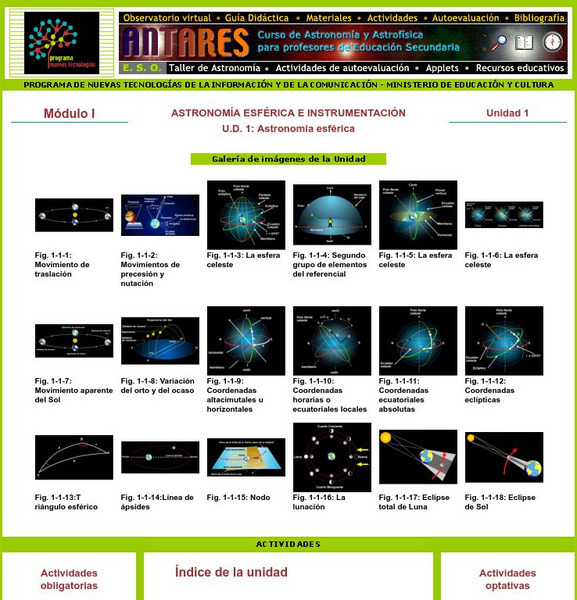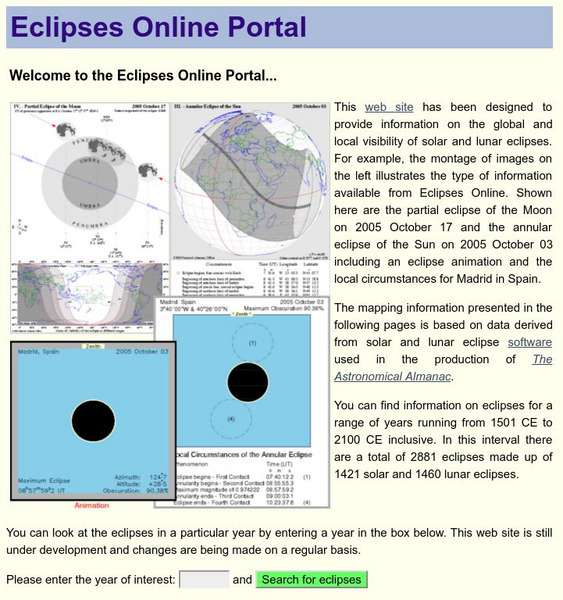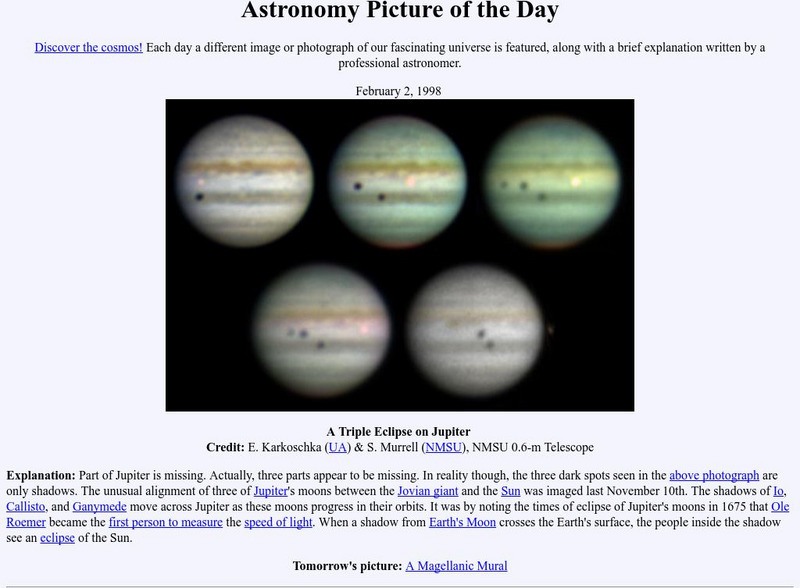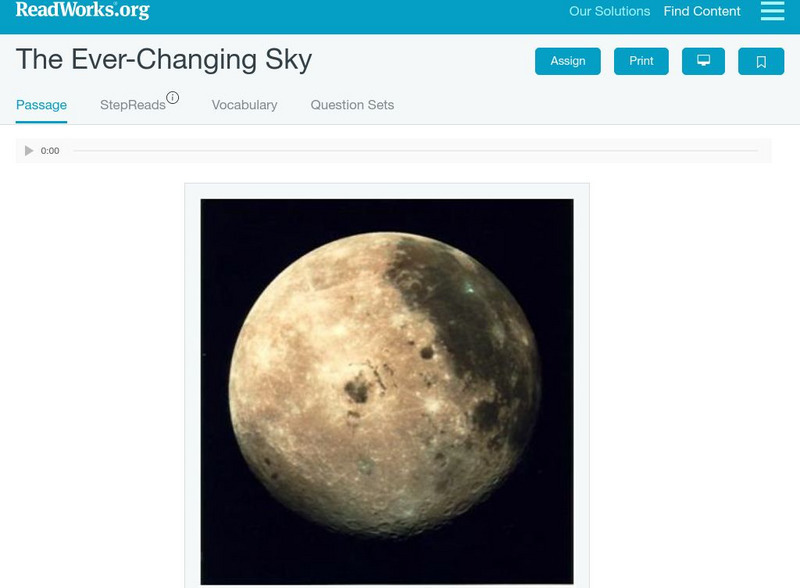Other
The Total Solar Eclipse Described by Plutarch Pdf [Pdf]
An exploration of the total eclipse of the sun described by Plutarch in his DE FACIE IN ORBE LUNAE. Requires Adobe Reader.
CommonLit
Common Lit: "What Is an Eclipse?" by Nasa
CommonLit.org is a wonderful resource to use in a Language Arts classroom. Each story or article is accompanied by guided reading questions, assessment questions, and discussion questions. In addition, students can click on words to see...
Cosmos 4 kids
Cosmos4 Kids: Systems: Eclipses
Find out about the differences between solar and lunar eclipses and what causes both events to occur.
Ministerio de Educación (Spain)
Ministerio De Educacion: Atronomia Esferica Modulo I Unidad 1
Recognize the major constellations and learn about the sky during the different seasons of the year. You will also be able to measure the height of the mountains of the moon.
Ministerio de Educación (Spain)
Ministerio De Educacion: Astronomia Para Ninas Y Ninos
Learn basic astronomy and travel through space. After you finish the lessons you can take the evaluation to obtain the clues needed to play the fun space games.
Other
Eclipses Online: Solar & Lunar Eclipses
This resource explores both solar and lunar eclipses from the past, the present, and the future. It gives detailed explanations to where the eclipse was and when it will happen again. Enter a year in the search box to find eclipse...
Other
Eclipses Online
This resource explores both solar and lunar eclipses from the past, the present, and the future. It gives detailed explanations to where the eclipse was and when it will happen again. Enter a year in the search box to find information...
Space.com
Space: 'Snow Moon' Eclipse & Green Comet a Double Treat for Skywatchers
A penumbral lunar eclipse and a bright green comet gave skywatchers across the globe a double treat Friday night (Feb. 10) and early into Saturday morning.
NASA
Nasa: Central Solar Eclipse Paths: 1991 2050
Resource provides links to maps and path coordinates for every solar eclipse from 1991 through 2050.
Scholastic
Scholastic: Study Jams! Science: Our Solar System: The Moon
A slideshow and a short multiple-choice quiz on the moon. It discusses the moon's phases, its rotation, and characteristics of the moon.
NASA
Nasa: Eye Safety During Solar Eclipses
This resource, which is provided for by NASA, gives great information on protecting your eyes during solar eclipses. Your eyes are very difficult to replace. Even when 99% of the Sun's surface is obscured during the partial phases of a...
NASA
Nasa: Astronomy Picture of the Day: Jupiter
A triple eclipse crossing the face of Jupiter on 2 Feb 98. This set of five images captures the passage of the shadows of Io, Callisto, and Ganymede across the face of Jupiter.
Read Works
Read Works: The Ever Changing Sky
[Free Registration/Login Required] This informational text passage shares observable aspects of the sun and the moon. This passage is a stand-alone curricular piece that reinforces essential reading skills and strategies and establishes...
NASA
Nasa: Eclipses
The periodicity and recurrance of eclipses is governed by the Saros cycle, a period of approximately 6,585.3 days (18 years 11 days 8 hours). It was known to the Chaldeans as a period when lunar eclipses seem to repeat themselves, but...
Michigan Reach Out
Reach Out michigan.org: Phases of the Moon
This site explains the phases of the moon and an easy way to remember waxing and waning. Students have to explain a given phase to their classmates with a model.
Views of the Solar System
Views of the Solar System: Sun
Explore the sun through this site that includes vivid multimedia resources. Learn sun statistics and view numerous images of the sun and eclipses.
Cornell University
Cornell University: Astronomy: Aristarchus
This site from Cornell University provides a discussion of how Aristarchus arrived at his conclusions of the distance from the Earth to the Sun and Moon. Also has his methods for determining the size of the Moon and the Sun.
The Wonder of Science
The Wonder of Science: Ms Ess1 1: Earth Sun Moon System
Develop and use a model of the earth-sun-moon system to describe the cyclic patterns of lunar phases, eclipses of the sun and moon, and seasons.
Cornell University
Cornell University: Astronomy: Eclipses
This site from the Astronomy Department of Cornell University provides brief introduction to both solar and lunar eclipses. Links are provided for pictures and charts of the eclipses, and this is a good site to check out on the subject.
Ministerio de Educación (Spain)
Ntic: Astronomia Visible
In this site you can learn about stars, planets, satellites and a little history of Astronomy.
Ducksters
Ducksters: Astronomy for Kids: Glossary and Terms
Kids learn about the glossary and terms for the science of astronomy including words and definitions such as asteroid, comet, meteoroid, galaxy, eclipse, etc.
Shmoop University
Shmoop: Eclipse
Stephenie Meyer's third installment in the Twilight series finds the main character, Bella in great danger. Read about Bella, the other characters, themes and more information on the plot in this exccellent site.
Science Fun for Everyone
Science Fun: Solar Eclipse Kit
Create your own solar eclipse with this science experiment. *This experiment is not to be used to look at the actual sun. Looking directly at the sun can be harmful.*
Curated OER
Nachohat: Eclipse Information
From Perth, Western Australia, this site from Nachohat provides information about all eclipses across Earth. Links to recent eclipses provide lots of details and some video links.


![The Total Solar Eclipse Described by Plutarch Pdf [Pdf] Unit Plan The Total Solar Eclipse Described by Plutarch Pdf [Pdf] Unit Plan](https://d15y2dacu3jp90.cloudfront.net/images/attachment_defaults/resource/large/FPO-knovation.png)

















